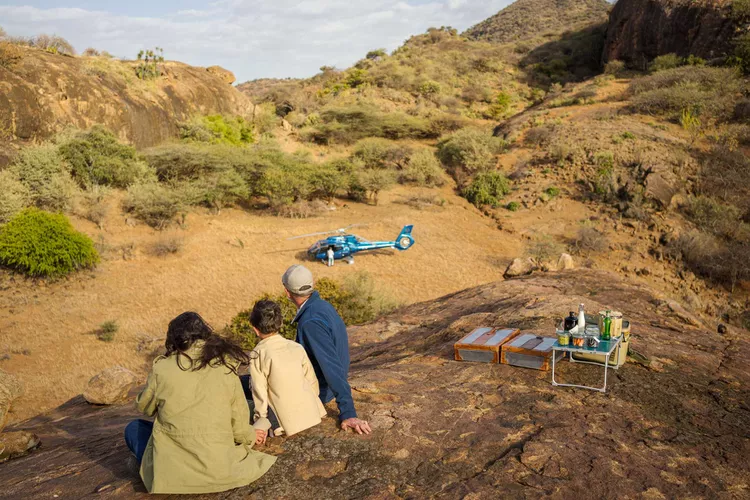Summary
Setting the Scene for Family Safari
This may not seem like the ideal moment to take the kids on safari. However, choose your destination — and your travel advisor — wisely, and you can pull off the perfect family trip.
As we touched down at Cottar’s 1920s Camp, set on a private 7,600-acre conservancy less than a mile from the Masai Mara National Reserve, much felt familiar. The dirt landing strip, stark and rust-colored under a bluebird sky. The Land Cruiser, stocked with blankets. The sense of anticipation that comes at the start of every safari. The knowledge that wildlife would soon be in sight.
The Thrilling Experience of Kenyan Safaris
There were also some differences during our visit last July. After the hellos and how are yous, our lead Masai guide, Joseph Mpoe, broke the ice: “We are fully vaccinated,” he shouted, masked, from the driver’s seat, while gesturing at his copilot, Lesasi Mako. In that instant, traveling with a then-unvaccinated five-year-old, my husband and I dropped our shoulders a bit, and smiled underneath our masks.
Tourism has restarted in earnest in Kenya — with intrepid American families like ours driving much of the business. In the summer of 2020, Kenya was one of the first nations to open to international visitors; just 14,409 travelers showed up that August. By the next August, the number had grown to 78,548, with Americans making up the largest share, at 21 percent.
“The American family market has been extraordinarily resilient during COVID,” said Calvin Cottar, a member of the fourth generation of Cottars to run safaris in Kenya. During our visit, he was personally guiding a multigenerational American party staying in the camp’s five-bedroom Private Bush Villa. Such groups are increasingly choosing Kenya for its strict health measures — mask mandates, a government push to vaccinate hospitality workers despite limited stockpiles — as well as refreshed camps and, as our family discovered, thoughtful children’s programming.
Accommodations and Activities for Families
Our two-week journey was organized by Deborah Calmeyer, a member of the GoTravelDaily A-List and the founder of luxury safari company Roar Africa. She had us kicking off our trip at Finch Hattons Camp, in Tsavo West National Park, because of the variety of experiences on offer there. Our son, Bobby, was able to burn off his excess energy swimming in the huge communal pool and, at the camp’s Masai Warrior School, learn how to use a bow and arrow. (Favorite group activities for older children include the hour-long hike up Oldoinyo Ololarami hill or an outing to the lush Chyulu Hills cloud forest.)
In Serengeti, Women Are Making History at the First All-Female-Run Safari Camp
At Segera, in northern Laikipia County, we stayed in the new two-bedroom Greenhouse villa, ideal for our trio, and took a walk with the lodge’s anti-poaching canine unit. Bobby was fascinated to learn how the three bloodhounds — Lindsey, Mickey, and Stevie — track a scent.
“Kenya has been our biggest driver of bookings this year by far,” Calmeyer told me near the end of 2021. The diversity of experiences has been a boon for Kenya because ever-changing testing requirements and border restrictions continue to make multi-country itineraries in Africa a logistical nightmare. “You could be at Finch Hattons in Tsavo, seeing Mount Kilimanjaro and all the cool volcanic rock,” she said. “Or at Segera, in the dry, malaria-free grasslands of Laikipia, staring at Mount Kenya. And then, of course, in the Mara, surrounded by all that wildlife.”
Nicky Fitzgerald, founder of the luxury camp Angama Mara, told me that 80 percent of her guests these days are Americans, with multigenerational groups making up a growing share. “There’s a whole phenomenon of ‘let’s get away from it all and reconnect with who we are,'” Fitzgerald said. In part because of that growing demand, Angama added a mobile four-bedroom safari camp in 2020 that follows animal migration patterns. “It’s Robinson Crusoe on steroids,” she said.
Memorable Moments in Kenya
We spent one night in the tented camp, accompanied by the Angama crew and two park rangers. After a delicious four-course dinner with our guide, Daniel Njiriri, we retired to a spacious, modern tent, our pressed sheets warmed up by hot-water bottles. Later that night, I lay awake, listening to lions call to one another in the distance.
Though many camps say they don’t accept children under age six, exceptions can be made. “We have a direct conversation with the parents, assess the maturity level, and try to accommodate,” Fitzgerald said. “Teenagers are actually much harder to please since they are used to their devices,” she confided. “Little ones can go on a walk to collect poo with a guide for hours.”
Bobby was surprisingly patient at Angama, and throughout the trip. At Segera, he climbed into the front seat of our vehicle with our guide, Elvis Omae, and hung on his every word. Bobby went along on every morning and evening game drive, absorbing information even when we didn’t realize it; months later, sitting in a friend’s living room, he pointed out a gray crowned crane depicted in a painting.
Shortly after our arrival at Cottar’s, we took a sunset game drive with Mako and Mpoe. We stopped at a hyena den to watch the cubs playing and nipping at their mothers’ heels. After a few minutes, Bobby did start to fidget. However, as we all marveled at the family in front of us, I realized what a joy it was for our little pack to be together in the wilderness.
A version of this story first appeared in the March 2022 issue of GoTravelDaily under the headline Call of the Wild.





